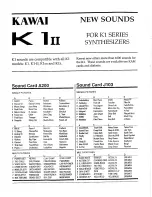
148
CHAPTER 12
Tips, Tricks& Words Of Wisdom
torting it, and finally sending the distorted signal
to a second filter, where it can be processed
again as you see fit.
Next to serving as a volume control for the OS-
CILLATOR section, in the right half of its control
range, the OSC VOL parameter lets you control
the gain level of the distortion module (SATU-
RATION) within a wide range of 12 decibels, ,
without increasing the volume level. At 24 deci-
bels, the control range of the "Digital" SATURA-
TION Curve is even greater. The OSC VOL knob
retains its function as a volume control in Input
mode as well as in Vocoder mode.
SATURATION CURVE: SHAPER
The Shaper’s saturation response differs from
that of the other SATURATION Curves. Its char-
acteristic curve is a sine wave with several cy-
cles. The Shaper lets you radically bend signals,
whereby the results are at times reminiscent of
the spectra of linear frequency modulation. The
response of the Shaper depends largely on the
input signal. This means that the Filter-1 set-
tings have a profound impact on the outcome.
You should use Filter-2 independently of Filter-1
in order to further process the raw output signal
of the Shaper. As is the case with the other
SATURATION Curves, the OSC VOL parameter
is used to tweak the characteristics that shape
its timbre . In particular in the case of the Shap-
er, this knob influences the complexity of the
generated sound to a considerable degree.
LFOS
LFO ENV MODE
In addition to their standard function as low fre-
quency oscillators, LFO 1 and 2 can also serve
as additional, albeit simple, envelopes. When
you activate ENV mode, the selected LFO
waveform will cycle through just once when you
play a note. This lets you use a sawtooth wave
to create a ramp, the shape of which you can
vary from linear to exponential by means of LFO
CONTOUR. The polarity of the respective
AMOUNTs determines if you end up with an as-
cending or a descending ramp. If, on the other
hand, you choose a triangle for your waveform,
you will end up with an ascending phase (at-
tack) and a descending phase (decay). The LFO
CONTOUR parameter also lets you determine
the relative rates of the attack and decay phas-
es. The absolute rate of the envelope is deter-
mined with the LFO RATE knob.
Summary of Contents for Virus Rack XL
Page 1: ...ENGLISH VERSION ...
Page 3: ......
Page 7: ...ACCESS VIRUS RACK XL OS5 7 PDF VERSION RESTRICTIONS APPLY ...
Page 10: ...10 CHAPTER 3 ...
Page 11: ...Prologue ...
Page 14: ...14 CHAPTER 4 Prologue ...
Page 15: ...Introduction ...
Page 26: ...26 CHAPTER 5 Introduction Her is the filter routings capabilities of the Virus ...
Page 39: ...Concept and Operation ...
Page 56: ...56 CHAPTER 6 Concept and Operation ...
Page 57: ...The Parameters ...
Page 113: ...The Multi Mode Parameters ...
Page 118: ...118 CHAPTER 8 The Multi Mode Parameters ...
Page 119: ...The Global Parameters ...
Page 129: ...The Vocoder ...
Page 134: ...134 CHAPTER 10 The Vocoder ...
Page 135: ...The Virus and Sequencers ...
Page 142: ...142 CHAPTER 11 The Virus and Sequencers ...
Page 143: ...Tips Tricks Words Of Wisdom ...
Page 156: ...156 CHAPTER 12 Tips Tricks Words Of Wisdom ...
Page 157: ...Appendix ...
Page 188: ...188 CHAPTER 13 Appendix ...
Page 189: ...Index ...
















































